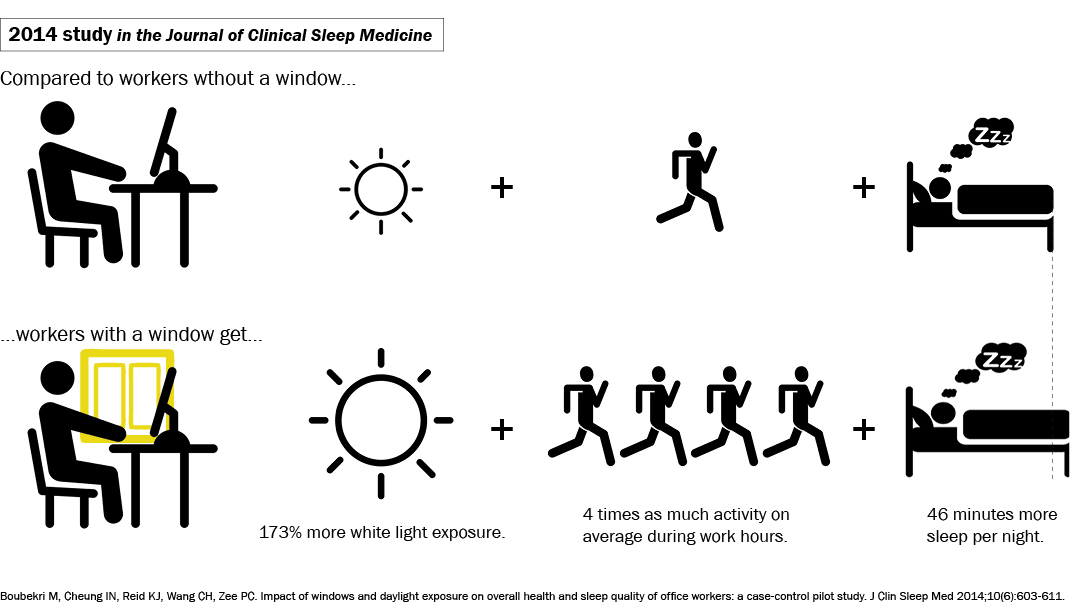Building Performance, Human Performance

How much does the building performance correlate to human performance? Here's some of the research in four categories, ten graphics.
1. DAYLIGHT
Studies looking at daylight often look for correlations between daylight and circadian entrainment. With exposure to more daylight, the body's cycles synchronize with its natural circadian rhthyms helping people fall asleep sooner and stay asleep, which has repurcussions on productivity throughout the day.
More on circadian rhythyms here.
The below study looked at 27 workers in windowless offices and 22 workers in offices with significantly more daylight - other factors like physical activity outside of work, exposure to daylight/nature and male/female were found to be balanced between the groups and the difference not of statistical significance. Actigraphy recordings (akin to a Fitbit) measured light exposure, activity and sleep-wake patterns. Workers without windows reported poorer overall sleep quality.
This next study examined both physiological differences and behavioral differences, comparing nurses with greater daylight access to those without it. Although the physiological differences were not statistically significant (top row), the behavioral differences were more pronounced (bottom row). Consider how a better mood for nurses might have long term effects on patient outcomes in a hospital and it's evident that an investment in daylight, though having an upfront cost, could have immeasurable payback in the long run.
The performance of students likewise improved. In the 1999 Heschong Mahone study, 21,000 students in three elementary school districts were studied. Elementary schools were chosen in particular because students at that age do not change classrooms during the day, providing the greatest environmental consistency. The study found the following...
2. VIEWS
This study found a correlation between sick leave and light quality and views. If a "healthy" building has effects in a measurable aspect such as sick days, (and this study did find these differences to be of statistical significance) then how might a good building --a well daylit building of narrow footprint allowing more views to the exterior-- affect productivity during the day?
The follow-up Heschong study found greater fatigue to be most strongly associated with lack of a view, while self-report of better health conditions were strongly associated with better views. Better views were "gauged by larger window size and greater vegetation content."
The daylit rooms in this 2003 study varied from the 1999 Heschong study not only because the windows were south facing and lacked shading control, but also because of lower than average acoustical performance. Here are the critical findings.
3. VENTILATION
At less than or equal to 15 cfm per student (the code minimum!) students performed 5-10% worse. Lowering the ventilation rate from 17cfm to 15cfm per person in another study resulted in a 15% increase in symptom prevalence of sick building syndrome.
4. TEMPERATURE
Getting temperature right matters too...
Finally, this pilot study from the University of Salford looked at 751 students in 34 classrooms through a combination of observational data, measured data and teacher interviews. The student progress was measured through multi-level analysis to avoid misleading results due to the nested structure of some data. The study separated school, pupil and teacher influences from the classroom environmental effects, finding that the built environment of the classroom had a 25% contribution to student development. Some of the studied factors included: daylight, clear and orienting corridors, acoustical performance, classroom flexibility and views to nature. As you can see in their diagram below, students in the best classroom environment improved by 11 points more on average than those in the worst classroom environment.
Barrett, Peter, Yufan Zhang, Joanne Moffat, and Khairy Kobbacy. “A Holistic, Multi-Level Analysis Identifying the Impact of Classroom Design on Pupils’ Learning.” Building and Environment 59 (January 2013): 678–89. doi:10.1016/j.buildenv.2012.09.016.
esearch in this area is ongoing, but there is increasing evidence that a high performing building makes a difference in human health, well-being and productivity at both work and school. The next time you are asked whether that skylight or window is really worth the extra cost, maybe these data can provide the answer.









